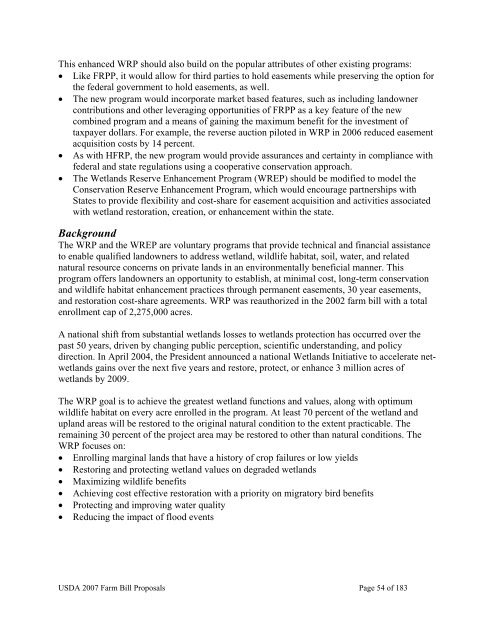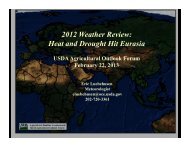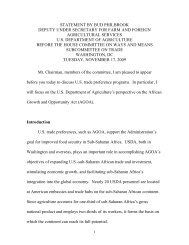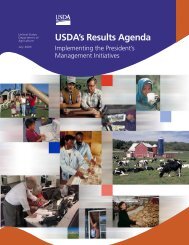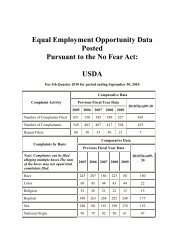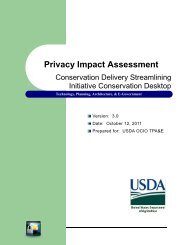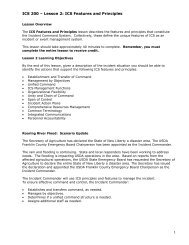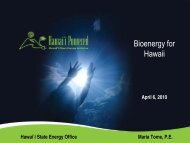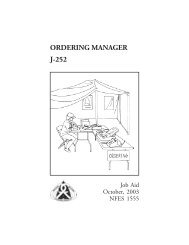USDA 2007 Farm Bill Proposals - US Department of Agriculture
USDA 2007 Farm Bill Proposals - US Department of Agriculture
USDA 2007 Farm Bill Proposals - US Department of Agriculture
You also want an ePaper? Increase the reach of your titles
YUMPU automatically turns print PDFs into web optimized ePapers that Google loves.
This enhanced WRP should also build on the popular attributes <strong>of</strong> other existing programs:• Like FRPP, it would allow for third parties to hold easements while preserving the option forthe federal government to hold easements, as well.• The new program would incorporate market based features, such as including landownercontributions and other leveraging opportunities <strong>of</strong> FRPP as a key feature <strong>of</strong> the newcombined program and a means <strong>of</strong> gaining the maximum benefit for the investment <strong>of</strong>taxpayer dollars. For example, the reverse auction piloted in WRP in 2006 reduced easementacquisition costs by 14 percent.• As with HFRP, the new program would provide assurances and certainty in compliance withfederal and state regulations using a cooperative conservation approach.• The Wetlands Reserve Enhancement Program (WREP) should be modified to model theConservation Reserve Enhancement Program, which would encourage partnerships withStates to provide flexibility and cost-share for easement acquisition and activities associatedwith wetland restoration, creation, or enhancement within the state.BackgroundThe WRP and the WREP are voluntary programs that provide technical and financial assistanceto enable qualified landowners to address wetland, wildlife habitat, soil, water, and relatednatural resource concerns on private lands in an environmentally beneficial manner. Thisprogram <strong>of</strong>fers landowners an opportunity to establish, at minimal cost, long-term conservationand wildlife habitat enhancement practices through permanent easements, 30 year easements,and restoration cost-share agreements. WRP was reauthorized in the 2002 farm bill with a totalenrollment cap <strong>of</strong> 2,275,000 acres.A national shift from substantial wetlands losses to wetlands protection has occurred over thepast 50 years, driven by changing public perception, scientific understanding, and policydirection. In April 2004, the President announced a national Wetlands Initiative to accelerate netwetlandsgains over the next five years and restore, protect, or enhance 3 million acres <strong>of</strong>wetlands by 2009.The WRP goal is to achieve the greatest wetland functions and values, along with optimumwildlife habitat on every acre enrolled in the program. At least 70 percent <strong>of</strong> the wetland andupland areas will be restored to the original natural condition to the extent practicable. Theremaining 30 percent <strong>of</strong> the project area may be restored to other than natural conditions. TheWRP focuses on:• Enrolling marginal lands that have a history <strong>of</strong> crop failures or low yields• Restoring and protecting wetland values on degraded wetlands• Maximizing wildlife benefits• Achieving cost effective restoration with a priority on migratory bird benefits• Protecting and improving water quality• Reducing the impact <strong>of</strong> flood events<strong><strong>US</strong>DA</strong> <strong>2007</strong> <strong>Farm</strong> <strong>Bill</strong> <strong>Proposals</strong> Page 54 <strong>of</strong> 183


